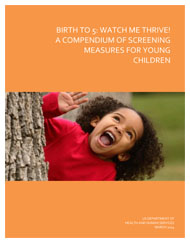Birth to 5: Watch Me Thrive!
Birth to 5: Watch Me Thrive! is a coordinated federal effort to encourage healthy child development, universal developmental and behavioral screening for children, and support for the families and providers who care for them.
Birth to 5: Watch Me Thrive! will help families and providers:
- Celebrate milestones. Every family looks forward to seeing a child’s first smile, first step, and first words. Regular screenings help raise awareness of a child’s development, making it easier to expect and celebrate developmental milestones.
- Promote universal screening. Just like hearing and vision screenings assure that children can hear and see clearly, developmental and behavioral screenings track a child’s progress in areas such as language, social, or motor development.
- Identify possible delays and concerns early. With regular screenings, families, teachers, and other professionals can assure that young children get the services and supports they need, as early as possible to help them thrive alongside their peers.
- Enhance developmental supports. Combining the love and knowledge families have of their children with tools, guidance, and tips recommended by experts can make the most of the developmental support children receive.
The Importance of Developmental and Behavioral Screening
As many as one in four children through the age of five are at risk for a developmental delay or disability. Early identification allows communities to intervene earlier, leading to more effective and cheaper treatment during the preschool years, rather than expensive special education services in later childhood.
This initiative draws heavily on previous developmental and behavioral screening efforts by consolidating materials from a wide array of federal agencies and their non-federal partners. As part of this initiative, we have published a list of research-based developmental screening tools appropriate for use across a wide range of settings. Select your appropriate audience from the list below to view a tailored guide for use with the compendium that addresses the importance of developmental and behavioral screening, how to talk to parents, where to go for help, and how to select the most appropriate screening tool for the population served as well as the provider implementing the screening.
Compendium of Screening Measures for Young Children
 The Compendium of Screening Measures for Young Children (PDF) is a collection of research-based screening tools for children under the age of 5. Practitioners in early care and education, primary health care, child welfare, and mental health can use this reference to learn cost, administration time, quality level, training required, and age range covered for each screening tool.
The Compendium of Screening Measures for Young Children (PDF) is a collection of research-based screening tools for children under the age of 5. Practitioners in early care and education, primary health care, child welfare, and mental health can use this reference to learn cost, administration time, quality level, training required, and age range covered for each screening tool.
Additional Resources
- Learn the Signs. Act Early
- Use the Developmental Screening Passport to keep track of and share your child’s screening history and results. Download a printable version.
- Find Help Near You
- Explore resources for Behavioral Health, Child Welfare, Communities, Early Care and Education, Early Intervention, Home Visitation, and Primary Care.
- Birth to 5: Watch Me Thrive! Initiative Summary/Del nacimiento a los 5 ! Información y Destacados (PDF)
Federal Partners
The federal partners contributing to this initiative include:









